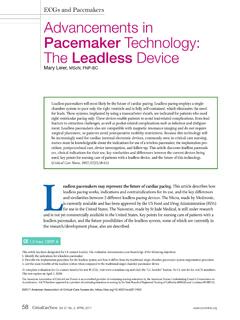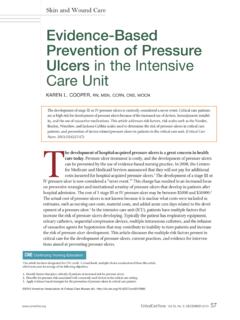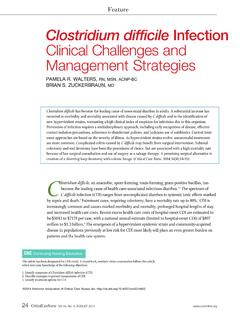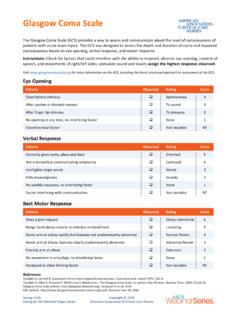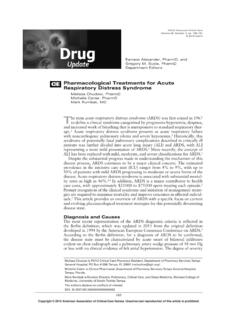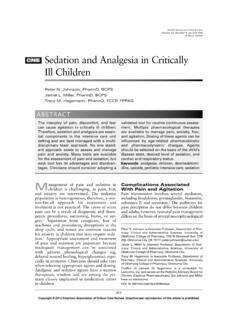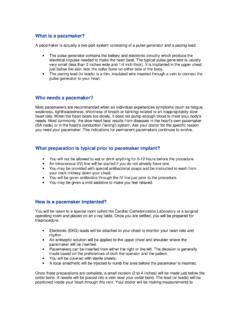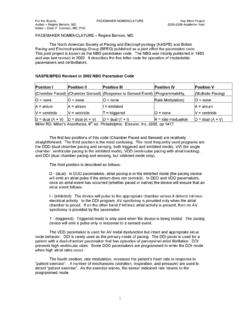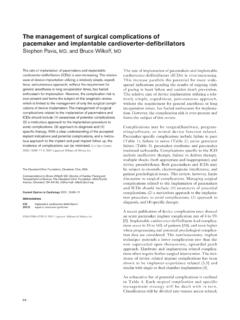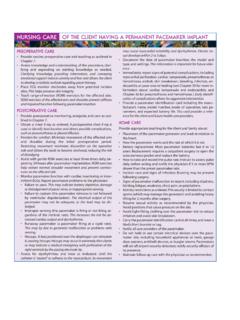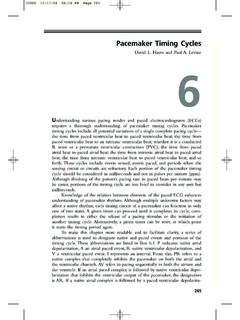Transcription of Biventricular Pacemakers in Patients With Heart Failure
1 Heart Failure is a debilitating chronic condition that affects more than 5 millionpatients in the United condition is complex and incurable, but multiplemedications, procedures, and devices are available to treat it. Biventricular pacing,a therapy for some Patients with Heart Failure , can improve quality of life and reducethe number of hospitalizations and ,3In this article, I discuss selection ofpatients and devices, the procedure used to implant the pacemaker , potential complications, andassessment of the function of Biventricular Pacemakers .
2 Nurses who provide care for Patients withpermanent Pacemakers and Biventricular Pacemakers should be knowledgeable in the assessmentof electrocardiographic (ECG) findings related to adequate functioning of Biventricular addition, I provide bedside critical care or telemetry nurses the information to determine if abiventricular pacemaker is functioning and when to contact a cardiologist to determine if furtherinterrogation of the pacemaker or correction of timing is for Biventricular Pacing in Heart FailureMultiple indications exist for implanting a Biventricular pacemaker in Patients with Heart Failure .
3 And the indications are continuously being reevaluated to include a broader range of Patients with thediagnosis of Heart Failure . According to the Heart Failure Society of America, Biventricular pacing isrecommended for Patients with sinus rhythm, a widened QRS interval greater than 120 ms, and a leftBiventricular Pacemakers inPatients with Heart FailureKAREN LESLIE COOPER, MSN, CCRN, CNS, WOCNThis article has been designated for CE credit. A closed-book, multiple-choice examination follows this article,which tests your knowledge of the following objectives:1.
4 State indications for Biventricular pacemaker therapy2. State the electrocardiographic changes in assessment of Biventricular pacing function3. State complications related to Biventricular pacemaker therapy 2015 American Association of Critical-Care Nurses doi: Continuing Nursing EducationCoverPatients with Heart Failure may benefit from implantation of a Biventricular pacemaker . This article discussesthe indications for Biventricular pacemaker implantation and the assessment of Patients with biventricularpacemakers. Biventricular Pacemakers require more assessments than do traditional single- or dual-chamber Pacemakers .
5 (Critical Care ;35[2]:20-28)20 CriticalCareNurseVol 35, No. 2, APRIL ejection fraction (LVEF) of 35% or one-third of Patients with systolic heartfailure have left bundle branch block with a QRS dura-tion greater than 120 (p388)Indications noted by theAmerican Heart Association for Biventricular pacinginclude LVEF of 35% or less, left bundle branch block withQRS duration 150 ms or greater, and Heart failuregreater than class II according to the New York HeartAssociation classification6,7(Table 1). These criteria aredynamic, and selection of the device to be used and thedecision to implant a device may depend on a patient ssigns and symptoms and decreasing functional statusand local insurance-related criteria for with New York Heart Association level I or levelII Heart Failure may be eligible for insertion of a biven-tricular pacemaker if the ejection fraction is less than30% and the QRS interval is 130 ms or.
6 8 Biventricular pacing may also be considered forpatients with atrial fibrillation and a QRS interval greaterthan 120 ms and LVEF less than 35% with persistentmoderate to severe Heart pacingwith defibrillation capability is recommended for patientswho meet criteria for Biventricular pacing who have alsohad cardiac arrest or who have evidence of ventriculartachycardia not due to a potentially reversible decision to implant a Biventricular pacemaker withdefibrillation capability to prevent sudden cardiac deathmay also be made for other selected Patients .
7 Depend-ing on the model of pacemaker chosen and pacemakerprogramming, inclusion of defibrillation capability isan elective option. Implanted devices with defibrillatingcapability are known as cardiac resynchronization therapydefibrillators (CRT-Ds).Ventricular Dyssynchrony in Heart FailureA QRS duration greater than 120 ms in a patientwith chronic Heart Failure may indicate ventricular dys-synchrony (the left and right ventricular contractions donot occur simultaneously and result in impaired ejection).Left bundle branch block is a common cause of QRSduration greater than 120 ms.
8 In left bundle branch block,the left ventricle is activated through the septum, butactivation through the left ventricle is delayed, resultingin delayed contraction of the posterolateral left ventricularwall and delayed ejection from the left ventricle comparedwith the right ventricle. Doppler echocardiography maybe used to show ventricular dyssynchrony, but 12-leadECG evidence of prolonged QRS duration is the gold stan-dard for indicating electromechanical ventricular an intraventricular conduction delay is present,coordination in the timing of peak contraction withinleft ventricular segments is lacking, causing intraventric-ular dyssynchrony.
9 Additionally, a lack of coordinationbetween left and right ventricular systole, or intraven-tricular dyssynchrony, occurs. Furthermore, delayedsystolic contraction of left ventricular segments resultsin reduced diastolic filling time with loss of atrial kick(responsible for 25% of ventricular filling). In patientswith Heart Failure , this dyssynchrony may furtherimpair the ability of the left ventricle to pump effectively,Karen Leslie Cooper is a clinical nurse specialist at Sutter Auburn Faith Hospital, Auburn, author: Karen Leslie Cooper, MSN, CCRN, CNS, WOCN,Sutter Auburn Faith Hospital, Auburn CA 95602 (e-mail: purchase electronic or print reprints, contact the American Association of Critical-Care Nurses, 101 Columbia, Aliso Viejo, CA 92656.)
10 Phone, (800) 899-1712 or (949)362-2050 (ext 532); fax, (949) 362-2049; e-mail, and symptomsCardiac disease, but no signs or symptoms (eg, shortness of breath when walking, climbing stairs) and no limitationin ordinary physical activityMild signs or symptoms (eg, mild shortness of breath and/or angina) and slight limitation during ordinary activityMarked limitation in activity due to signs and symptoms, even during less-than-ordinary activity (eg, walking shortdistances of 20-100 m), comfortable only at restSevere limitations; experiences signs and symptoms even while at rest.
